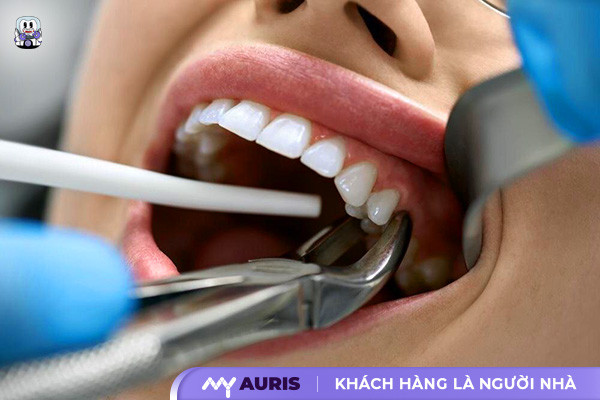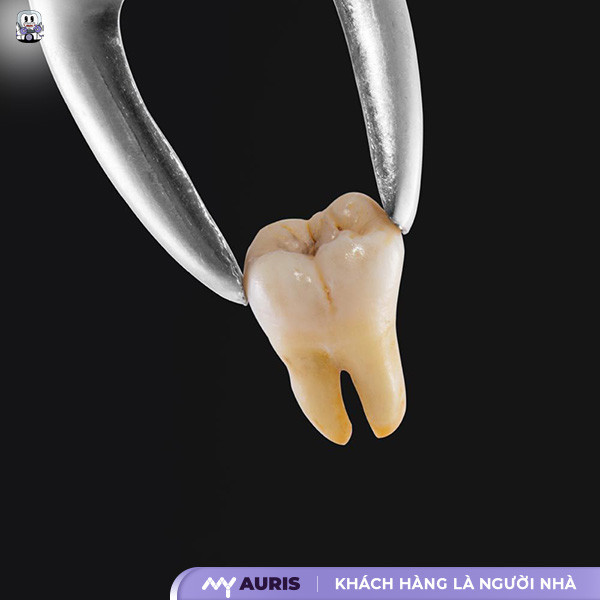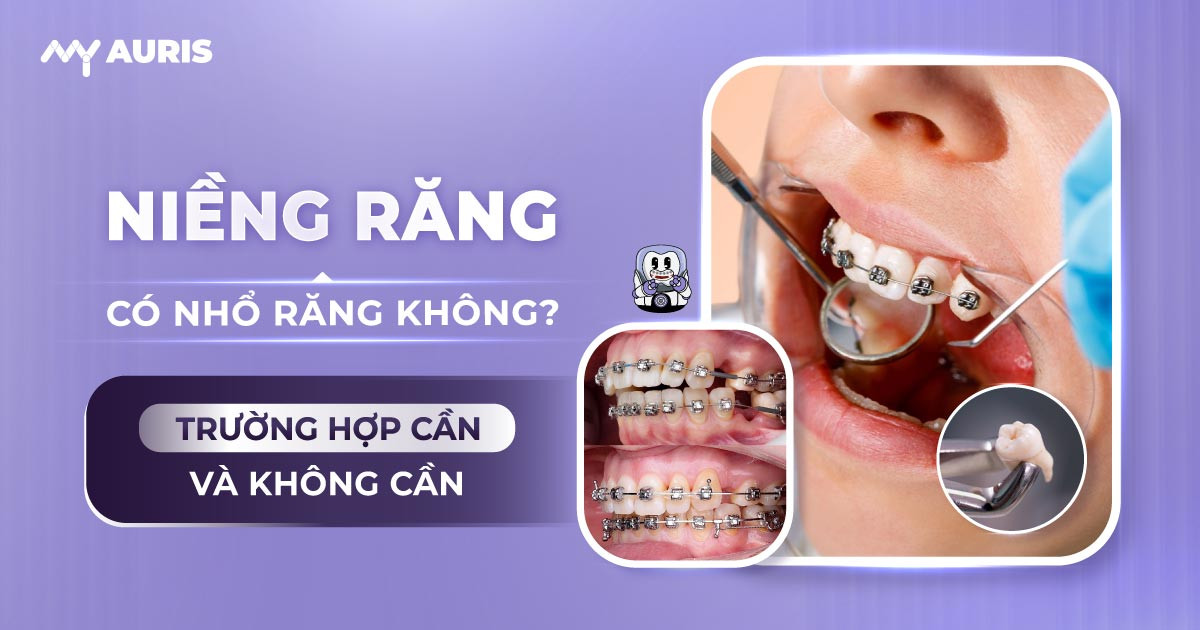“Does braces require tooth extraction?” is a common question for many people preparing for orthodontic treatment. The prospect of tooth extraction before braces can cause anxiety due to fears of pain, discomfort during eating, and concerns about overall oral health. However, not everyone needs tooth extraction during orthodontic treatment. To better understand this issue, and to find optimal solutions to minimize the need for tooth extraction during braces, let My Auris provide detailed insights in the article below.
[Explanation] Do Braces Require Tooth Extraction?
Many people wonder if tooth extraction is mandatory for braces. The answer is Not Always Necessary. Whether or not tooth extraction is required will depend on your oral health condition and the orthodontic method prescribed by your doctor.
If there is sufficient space in the jaw for teeth to move, the dentist will apply a non-extraction bracing technique, helping to maintain a uniform dental arch and achieve aesthetic standards without the need for tooth extraction. However, to determine this accurately, you should visit a reputable dental clinic for examination, X-rays, and detailed consultation.
Although not everyone needs tooth extraction, it may be necessary in some cases, such as:
- Protruding jaw/bones, with insufficient space for teeth to move.
- Severely crowded or misaligned teeth.
- Supernumerary teeth or impacted teeth affecting the bite.
Tooth extraction during the bracing period helps create space, supports teeth movement to the correct position, achieves optimal dental aesthetics, and minimizes the risk of shifting after braces.

Cases When Tooth Extraction is Needed and Not Needed for Braces
Determining whether tooth extraction is necessary for braces depends on each individual’s specific oral condition. Below are the cases where tooth extraction is needed and not needed before braces to ensure optimal orthodontic effectiveness.
Patients Who Need Tooth Extraction for Braces
Some cases absolutely require tooth extraction during braces to create space for teeth to move to the correct position, achieve proper bite alignment, and improve chewing function:
- Severe overjet (protruding teeth) and underbite (under-erupted teeth): When teeth protrude excessively or are set back too much, hindering tooth movement, extraction is necessary.
- Crowded teeth: If teeth are growing haphazardly with insufficient space in the dental arch, the dentist will recommend extraction to create space for teeth rearrangement.
- Malocclusion: When the two jaws do not align properly, extracting some teeth can help balance the bite and enhance the effectiveness of orthodontic treatment.
- Supernumerary or impacted teeth: Some individuals have extra teeth, impacted teeth, or unerupted primary teeth, preventing permanent teeth from erupting correctly. In such cases, extraction will provide sufficient space in the dental arch for teeth to move.

Patients Who Do Not Need Tooth Extraction for Braces
In many cases, if the dental arch is wide or already has existing space, the dentist may recommend non-extraction orthodontic treatment:
- Spaced teeth: If there are natural gaps between teeth, they can move easily without needing additional space.
- Crooked teeth but with a wide dental arch: For individuals with a large arch, misaligned teeth can still be rearranged without extraction.
- Children in the “golden age” for braces (6 – 12 years old): At this age, the jawbone is developing, and orthodontic appliances like expanders can help create space without invasive extraction.
Teeth Commonly Recommended for Extraction During Orthodontic Treatment
Many people wonder if braces require tooth extraction, and if so, which teeth need to be removed. In practice, dentists often recommend extracting first premolars (tooth #4), second premolars (tooth #5), and especially wisdom teeth (#8), to ensure optimal orthodontic effectiveness.
First Premolar (Tooth #4)
- The first premolar (tooth #4) is located in the middle of the dental arch and does not play a crucial role in chewing function.
- It is typically indicated for extraction when teeth are crowded, experiencing an underbite, or pushing against each other.
Second Premolar (Tooth #5)
- The second premolar (tooth #5) also does not have a critical function and is extracted when additional space is needed.
- It helps in arranging teeth more evenly and improving the bite.
Wisdom Tooth (#8)
- Wisdom teeth (#8) often erupt impacted or misaligned, causing crowding of adjacent teeth.
- This can lead to complications such as inflammation, pain, and negatively affect the outcome of braces.
- Extracting wisdom teeth before wearing braces helps minimize their negative impact.

Answers to Questions About Tooth Extraction for Braces
Can Braces Be Done Without Tooth Extraction?
It is absolutely possible to get braces without tooth extraction if the dental arch is wide or teeth are spaced, with existing gaps for teeth to move. Especially for children aged 6-12, tooth extraction is often not necessary as their jawbones are soft and developing, allowing teeth to be easily adjusted without invasive intervention.
Does Tooth Extraction for Braces Have Any Side Effects?
Tooth extraction for braces typically does not negatively affect oral health or chewing function. The teeth indicated for extraction, such as first premolars (#4), second premolars (#5), and wisdom teeth (#8), usually have little impact on chewing ability, ensuring a smooth orthodontic process and effective correction of dental misalignments.
How Many Teeth Need to Be Extracted Before Braces?
The number of teeth to be extracted for braces depends on the jaw structure, dental condition, and the treatment plan developed by the orthodontist. For cases of crowded, misaligned teeth or malocclusion, tooth extraction helps create space to ensure proper movement of the front teeth, achieving a balanced midline and correct bite.
Why Does Braces for Overbite Often Require Tooth Extraction?
An overbite is often caused by a small jawbone, crowded teeth, or front teeth protruding forward. Tooth extraction creates space to retract the front teeth, ensuring they move to the correct position and preventing shifting or recurrence of the overbite. However, not all cases of overbite braces require extraction. The most important step is to have an examination and receive a personalized treatment plan from an orthodontist.
A successful bracing process concludes when teeth have moved in the correct direction, achieving a proper bite and ideal intercuspation, allowing for comfortable chewing and maintaining strong, healthy teeth. This requires the high skill of the orthodontic team.
At My Auris, experienced orthodontists (over 10 years) will conduct a detailed examination of your bite and jawbone, proposing optimal clear aligner or traditional braces options. The process is diligently monitored, and tooth extraction is only performed when absolutely necessary, ensuring a healthy, beautiful smile that radiates confidence.





